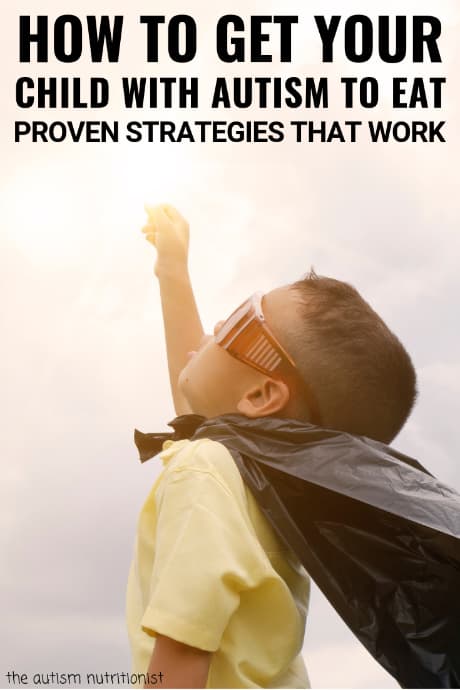
Feeding problems are seen in the vast majority of children with autism. Contributing factors include medical problems, psychological barriers, nutritional deficits, sensory disorder, oral-motor dysfunction, and environmental causes. These factors – alone or together – lead to food selectivity in up to 87% of children on the spectrum.
Parents come to me seeking to expand the diet of their picky eater with Autism Spectrum Disorder (ASD) not realizing that the eating behaviors they see are often more severe than typical picky eating. Children who eat under 20 foods, can’t tolerate introductions to new foods, drop once preferred foods without ever reintroducing them, and neglect entire food groups or food types are actually categorized as problem feeders. Many children with autism fall into the problem feeder category and actually won’t respond to many popular picky eating hacks.
You’ve probably been told “He won’t starve himself,” “He’ll eat when he’s hungry enough,” “She’ll outgrow this picky stage.” This isn’t true for many ASD children who have feeding problems.
What You Can Do To Help A Picky Eater with Autism
First, you should get your free guide for exposing your child to new foods. Then, try these three scientifically proven strategies to expand the diet of your problem feeder with ASD.
Positive reinforcement
Positive reinforcement is exactly what it sounds like. It is simply providing your child with verbal praise or tangible items for eating. It sounds a lot like bribing, but the practice is more intentional and is actually backed by science. Reinforcement of appropriate behaviors has been shown to be highly effective in motivating children with autism.
Verbal praise is the most commonly used to reinforce, but alternatives such as ‘token systems’ where the child can earn tangible rewards (like a favorite activity, extra screen time, or stickers) can also be effective.
Positive reinforcement with eating can be immediate (provided during feeding, after each bite or goal behavior) or delayed. Delayed rewards, such as charting progress on sticker chart, may be more effective for children who have already made progress. When using verbal praise, be very specific: “Great job trying a bite of carrots” “Thank you for being comfortable with the fish on your plate.”
Food chaining
Food chaining, a method that incorporates sensory integration and behavioral modification, is an effective approach that expands food repertoire by emphasizing similar features between accepted and targeted food items. A food chain originates with an accepted food (one that child eats willingly and reliably) and ends with a goal food. New for previously rejected foods are introduced between the accepted and targeted foods.
Chains can be long or short, simple or complicated. A common example of food chaining begins with a child’s favorite chicken nuggets and ends with acceptance of a mild white fish. In between might be other brands of chicken nuggets, different nugget shapes, different breadings, breaded fish nuggets, and eventually a plain mild white fish (maybe with a favorite dip). Another example of a food chain beginning with potato chips and ending in acceptance of a banana might look like this:
Food chaining can be a slow process, but it is effective. Of 10 children enrolled in a feeding program and treated with food chaining, all were able to increase their food repertoire over three months. After three months, the median number of accepted foods increased from five to 20.5.

Mealtime management
With all feeding strategies, it is best to incorporate structure and basic policies around eating. Children with ASD benefit from routines and clear expectations. Try these basic strategies that can support your efforts to expand the diet of your problem feeder on the spectrum:
-
Schedule 3 meals and 1-3 snacks daily
-
Limit grazing outside of meal and snack times
-
Limit beverages between meals, especially caloric beverages like milk, juice, or soda
-
Limit mealtimes to no more than 30 minutes
-
Expose child to a non-preferred food daily
-
Explore foods outside of meal time through activities like food play, food shopping, cooking, and gardening; Adventures in Veggieland has a ton of wonderful food play ideas and child-friendly recipes
-
Be a positive model by practicing the behavior you’d like to see
-
Do not beg, bribe, or force eating
I recommend Ellen Satter’s book Child of Mine: Feeding with Love and Good Sense for more ideas on creating productive mealtimes and fostering a positive feeding relationship with your child.
Recap
Problem feeding is common in ASD and typical picky eating tips might not work for your child. To expand the diet of your child with autism, consider a few basic strategies to create structure around mealtimes while you explore other strategies like food chaining and positive reinforcement.
Homework
Begin incorporating these strategies to improve picky eating. Start with just one change and gradually add new behaviors once that one is comfortable. It takes the brain 3 days to get used to something new, so don’t rush it.
The exact approach that have helped my clients see immediate results – in one easy-to-read guide.
Do you have yours yet?



This is excellent! I can’t wait to test these methods on my autistic toddler. The free guide though won’t populate for me to download so if you could send it to my email that would be amazing!
I would would very much like to have this guide for ASD picky eaters. I can’t find it though. We really need help!
Thank you
its very hard to potty train and to get her to eat other stuff , she use to eat spaghetti os the adult cans and now she turning away from that all she will eat is apple jacks and foot loops and banana shakes and juice I have gummy vitamins for her to which I put in her juice
How can I purchase the guide above….
Autism Food Rules? Where can I purchase it?